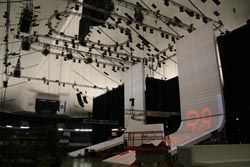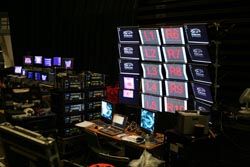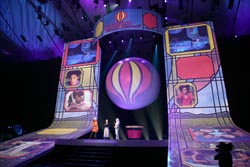- When Rite Aid Corporation, one of the nation's leading and growing drugstore chains, needed to rally 4,000 attendees at its annual conference, the company looked to AVMG, a staging and production company, to deliver a high-end, never-before-done show, and that's just what they did.
LMG and AVMG worked together to create an original display at RiteAid's annual conference.
After meeting with Rite Aid to discuss their wants and needs for the show, AVMG began with the conceptual design working with Corporate Magic. "They suggested running graphics seamlessly up the left side, across the top and then down the right side of the stage, and asked us if their concept was possible," explained Tom Miller, senior account services manager with AVMG. "We needed the concept to work, and we needed it to work within budget. So, we turned to LMG. In theory, we could have done vertical edge blended LEDs, but we were able to do this for a quarter of the budget."
Held at the Anaheim Convention Center, the event was themed "Success Is in Your Hands." Designed to keep audience members in close proximity to the presenters, the concept called for two vertical, skateboard-style ramps, one on stage left and one on stage right. Each vertical structure, measuring 90 feet per side, was composed of five screens. The ramps were capped by a horizontal marquee, with a helium balloon sphere suspended below the marquee.
Images could travel up the left vertical ramp, across the marquee and back down the right side of the ramp. Graphics on the left vertical panel represented where Rite Aid had been, while the right side represented where the company plans to go. With all that in mind, LMG and AVMG kicked off pre-production planning.
Setting Up for Success
This type of vertical edge blending had not been done before, particularly on this scale, so once LMG was brought in, they faced their first challenge. Their technical team needed to find the appropriate hardware with very limited choices.
After researching the market, LMG found a solid solution in AnalogWay's Di-Ventix box, which could effectively handle the show's vertical edge blending.
"We brought the box into the shop and conducted initial tests to be sure the technology did what the brochure said it would do," said Neil Morrison, video services manager with LMG. "And, indeed it did."
Once the hardware was set, LMG moved on to the math. With a 90 x 30 foot wide surface, LMG calculated how many projectors they would need, how many overlaps, what the overlaps would be, etc. "The Di-Ventix box was very flexible in how much overlap we had, and our overlap could vary from one box to the next," said Morrison.

As setup was carried out the venue, the Anaheim Convention Center, proved to be a challenge with its high ceilings and removable tiles.
With the vast number of pixels set to project on screen, it was crucial that the show material was produced to be played back from multiple sources providing a partial piece of the picture. That said, LMG had 15 sources to incorporate, and the Di-Ventix tops out at controlling three of its own machines at a time.
"We knew we had the right hardware in Di-Ventix, but we didn't have the right control mechanism for it," explained Kevin McCabe, director of technical services with LMG. "Medialon was our solution, and they worked very closely with AnalogWay to deliver."
Used more commonly for show control in theme parks and permanent installations, Medialon hit the mark. The equipment is designed to control not only Di-Ventix boxes but any tape machine, audio source, lighting equipment, show effects generator, basically any mechanical components of a show. In short, the Medialon control system tied all the production pieces together so the right sources appeared on screen at the right time.
"This was a unique opportunity for us because we had 10 projectors stacked vertically in two stacks of five. That had never been done before," explained Morrison. "Two additional, double-stacked projectors projected onto the sphere and marquee. Medialon was our first choice for controlling the environment. It was the only system able to control all the equipment we needed, including 12 AnalogWay boxes."
To help coordinate the timing, Dataton's WatchOut software was used, which allows for multiple outputs from a graphic source. The system was a pivotal component because it enabled flexibility regarding overlap and alignment in order to project a seamless image.
Troubleshooting on Site
After several months of pre-production planning, LMG and AVMG packed up their gear and headed west. Upon arrival, everyone was cautiously optimistic. "From the client to the show technicians, there was a lot of concern about alignment and effectiveness of how this was going to work," explained McCabe. "We tried to mitigate concerns by designing and custom building a projector mount operating on a yoke that allowed for flexibility once the projector was in the air. We also checked (and rechecked) the math and the design to assure the most success."
The venue itself also posed a challenge. It had a very high ceiling that allowed for a high vertical presence, but it consisted of hard, removable tiles, which made rigging a slow go.
During set-up, a Medialon representative was onsite with LMG working through show glitches as they came along. The Medialon system had never before been used as extensively with AnalogWay's equipment. "We found challenges with the software right way," said Morrison. "The Medialon rep retrieved the data from our machine and e-mailed it to Medialon's office in France around 11 p.m. our time. By morning, we had an e-mail with a newly designed module that completely resolved our issues. In this case, the time change worked completely to our advantage for an extremely quick turnaround."
Once LMG worked through the alignment grid, including all of the custom alignment grids that came from the Dataton operator, the technicians projected the images up on the screen. "People were blown away by the look - beyond all expectations. RiteAid was completely overwhelmed with the results, as were each of the technicians." recounted Morrison.

The production area backstage shows each screen's content stacked like the actual display on stage.
Pulling It Off
Vertical edge blending was born from market desire for the next best thing. "People used to be excited about wide screens," said Les Goldberg, CEO of LMG. "Now they're ready for something new."
With vertical edge blending, staging companies can work with tall and thin surfaces. In addition, large square screens are workable. In the past, technicians used 50' x 50' screens by throwing a lot of pixels away with a center cut. Now, it's possible to project images vertically with two 16 x 9 foot projectors overlapped, and virtually no pixels are thrown away.
"We learned a lot from our experience on the RiteAid show," said Goldberg. "I recommend a long pre-production planning phase. You're talking about complex mathematical and geometrical calculations. And, getting something into a 3-D CADD environment is helpful, too, or at least a multi-angle 2-D environment. It allows you to look for any possible problems with angles or obstructions. Finally, AnalogWay and Medialon worked hard with us to pull this show off. We were able to exceed the expectations of our clients with one of the most challenging projects yet."
In addition, having coordinated the project from start to finish, AVMG was thrilled with the results. "This talented group definitely accomplished a remarkable feat." said Keith Davenport, account services manager. For more information visit www.lmg.net.











